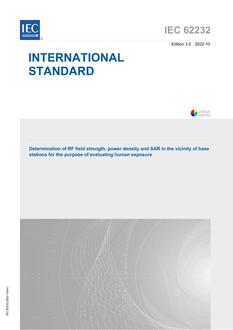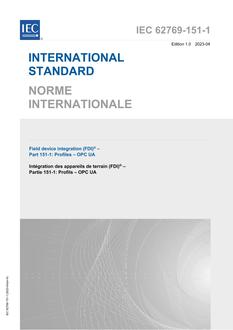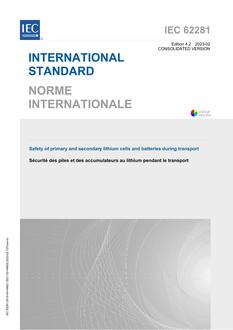
IEC 62232 Ed. 3.0 en:2022
This document provides methods for the determination of RF field strength, power density and specific absorption rate (SAR) in the vicinity of base stations (BS) for the purpose of evaluating human exposure.
This document:
a) considers intentionally radiating BS which transmit on one or more antennas using one or more frequencies in the range 110 MHz to 300 GHz;
b) considers the impact of ambient sources on RF exposure at least in the 100 kHz to 300 GHz frequency range;
c) specifies the methods to be used for RF exposure evaluation for compliance assessment applications, namely:
1) product compliance – determination of compliance boundary information for a BS product before it is placed on the market;
2) product installation compliance – determination of the total RF exposure levels in accessible areas from a BS product and other relevant sources before the product is put into operation;
3) in-situ RF exposure assessment – measurement of in-situ RF exposure levels in the vicinity of a BS installation after the product has been taken into operation;
d) specifies how to perform RF exposure assessment based on the actual maximum approach;
e) describes several RF field strength, power density, and SAR measurement and computation methodologies with guidance on their applicability to address both the in-situ evaluation of installed BS and laboratory-based evaluations;
f) describes how surveyors establish their specific evaluation procedures appropriate for their evaluation purpose;
g) provides guidance on how to report, interpret and compare results from different evaluation methodologies and, where the evaluation purpose requires it, determine a justified decision against a limit value;
h) provides methods for the RF exposure assessment of BS using time-varying beam-steering technologies such as new radio (NR) BS using massive multiple input multiple output (MIMO).
NOTE 1 Practical implementation case studies are provided as examples in the companion Technical Report IEC TR 62669:2019 [5].
NOTE 2 Although the current BS product types have been specified to operate up to 200 GHz (see, for example, [6] and [7]), the upper frequency of 300 GHz is consistent with applicable exposure limits.
NOTE 3 The lower frequency considered for ambient sources, 100 kHz, is derived from ICNIRP 1998 [2] and ICNIRP-2020 [1]. However, some applicable exposure guidelines require ambient fields to be evaluated as low as 3 kHz, e.g. Safety Code 6 [4] and IEEE Std C95.1-2019 [3].
NOTE 4 Specification of appropriate RF exposure mitigation measures such as signage, access control, and training are beyond the scope of this document. It is possible to refer to the applicable regulations or recommended practices on these topics.
NOTE 5 While this document is based on the current international consensus about the best engineering practice for assessing the compliance of RF exposure with the applicable exposure limits, it is possible that national regulatory agencies specify different requirements. The entity conducting an RF exposure assessment needs to be aware of the applicable regulations.
Product Details
- Edition:
- 3.0
- Published:
- 10/01/2022
- ISBN(s):
- 9782832257784
- Number of Pages:
- 346
- File Size:
- 1 file , 19 MB
- Note:
- This product is unavailable in Ukraine, Russia, Belarus


